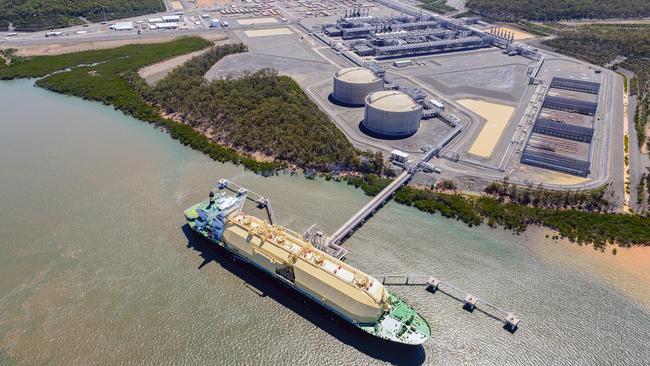Cheap exports undermine LNG windfall
LNG exports are likely to be sold to foreign buyers for the next two years at a cheaper rate than domestic gas.

Australian LNG exports are likely to be sold under contract to foreign buyers for the next two years at cheaper rates than most east coast domestic gas supply contracts are being offered, as lower oil price forecasts curb LNG prices and export revenue, according to the Office of the Chief Economist.
The subdued price outlook for LNG, which is expected to overtake coking coal as the nation’s second-biggest export after iron ore next year, has cut LNG export value forecasts issued by the federal Industry, Innovation and Science Department by $5.1 billion over the next two years.
And it has helped form expectations that mining and energy export revenue will fall next financial year, after hitting a record $211bn this year.
The lower export gas price expectations come with the east coast gas industry in the spotlight over domestic gas price rises and a 2018 domestic gas shortage prediction late last month by the Australian Energy Market Operator.
“The outlook for LNG prices has deteriorated in line with expectations for oil prices, to which LNG prices are linked,” the OCE said in its quarterly resources report yesterday.
“The OPEC production agreement has not been as successful as many expected in driving oil prices higher. In addition, US oil production has been stronger than expected, and forecasts of future production continue to be revised higher.”
As a result, LNG export revenue forecasts for this financial year have been cut by $1.8bn to $30.26bn and for next year by $3.3bn to $35.4bn.
Average LNG prices at Australian ports fell from an 18-month high of $9 a gigajoule in June to $8.20 a gigajoule in July, according to the latest available data.
The OCE is forecasting prices of Australian LNG sales — both contract and spot — will average $9.10 per gigajoule this year and next year.
This price, for gas that has been processed into LNG, is lower than the $10-$16 contract prices the Australian Competition & Consumer Commission last week said had been offered to east coast domestic buyers during 2017.
The political situation and industry agreement is likely to see the Santos-led Gladstone LNG plant continue to export contract volumes only, while Shell’s Queensland Curtis LNG plant and the Origin Energy/ConocoPhillips-led Australia Pacific LNG plant are likely to restrict spot sales.
This, and expected lower international spot prices amid a looming glut, could leave the nation’s export plants operating at below capacity and further reduce export volumes and values.
“Competition in global LNG markets is set to intensify over the next few years, and the average capacity utilisation of Australian LNG plants is expected to edge down,” the OCE said, noting there was uncertainty over future volumes.
“The extent of the decline will depend on the cost competitiveness of Australian LNG projects and the amount of flexibility in Australian LNG contracts.”
Spot LNG prices have run higher in recent months on increased demand from China and South Korea ahead of the northern winter, with some attributing the rise to the pressure on Queensland’s exporters to refrain from selling on spot markets.
But Macquarie analysts predict about 20 million tonnes a year of extra capacity will come online in the fourth quarter from the US, Australia and Russia, making strength in spot prices short-lived.
It is not all bad news on the export front.
The hit to LNG export revenue expectations this year has been more than offset by a price-led boost to iron ore expectations that has the OCE predicting a record $211bn of export earnings this financial year, up from previous predictions of $207bn.
But this is now expected to be the peak year for exports, with 2018-19 looking weaker and export forecasts cut to $201bn, from $209m in the previous report.
“The deterioration in the outlook for LNG prices is a significant driver of the downward revision,” the OCE said.
“In addition, lower-than-expected growth in iron ore production is expected to result in lower iron ore export volumes in 2018-19.”
Figures released yesterday show iron ore exports have pushed Australia’s trade surplus to just shy of $1bn in August, topping the expectations of economists.
The value of Australia’s iron ore exports jumped 10 per cent in August, as coal exports dipped 3 per cent and the value of all exports ticked 1 per cent higher.
The values of iron ore fines exported jumped 19 per cent or $645m, with overall quantities rising 7 per cent and unit values up 11 per cent. Fine exports to China leapt 25 per cent.
The iron ore price hovered well above $US70 a tonne in August, up from yesterday’s spot price of $US61.50 a tonne. Many analysts are predicting further declines as Chinese construction slows.
Additional reporting: Samantha Woodhill


To join the conversation, please log in. Don't have an account? Register
Join the conversation, you are commenting as Logout